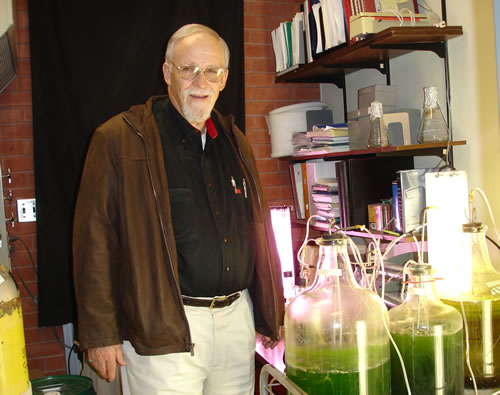Contents
- 1 Algae Coloring The Future Green eBook 2nd Edition Available at Amazon.com, Barnes & Nobles, Google Play , Smashwords and other eBooks Stores
- 2 Algae Coloring The Future Green 2nd Edition- Introduction
- 3 Algae Coloring The Future Green – Doubling their Mass in about 3-4 hours during Optimal Growth
- 4 Algae Coloring The Future Green Dedicated To Mike Cusanovich
Algae Coloring The Future Green eBook 2nd Edition Available at Amazon.com, Barnes & Nobles, Google Play , Smashwords and other eBooks Stores
AN INTRODUCTION TO THE USE OF ALGAE FOR SUSTAINABLE PRODUCTION OF FUEL, FEED, CHEMICALS AND PHARMACEUTICALS
The revised and applied 2n edition of the ebook Algae Coloring the Future Green of Drs. John Kyndt and Aecio D’Silva is intended for scientists, entrepreneurs, students, engineers, algae growers and investors that are interested in the potential algae have for fuel production, as well as, manufacture of high value chemicals, cosmetics and pharmaceuticals.
Algae Coloring The Future Green 2nd Edition- Introduction

Although algae have been thought of as a potential fuel source in the past, it wasn’t until the skyrocketing fossil fuel prices in 2008 that this miniscule source of power was taken seriously.
Previously mainly known as “pond scum” and a plague for pool owners and fish farms, algae are now being seen as a promising and emerging investment for future energy sources. In the last two years there have been several announcements of million dollar investments from both private and government sources into the algae for fuel concept.
Think for example of the Exxon-Mobile announcement of a $600 million investment in algae biofuels, and the recent $45 million DOE funding of the National Alliance on Advanced Biofuels and Bioproducts (NAABB) to perform algae-derived fuel research.
With all these million dollar investments and with even the world’s largest airplane maker, Boeing, turning its eyes on algae, it is clear that the race to develop the next generation fuel from algae is on.
The concept of using algae for fuel is remarkably simple. The fuel is essentially derived from algae that have captured energy through the photosynthesis of sunlight while growing in nutrient-rich water sources such as sewage ponds.
The algae use the energy to create biomass, while capturing carbon dioxide. Algae need in average 2.8 tons of CO2, 0.95 ton of nutrients, light and water to produce 1 ton of dry matter. The resulting biomass can be used for fuel production by a few possible pathways.
Depending on the biomass composition, it can be used to produce biodiesel (through transesterification), biojetfuel (through hydrocracking), or bioethanol (through fermentation). The biomass composition is dependent on the algae species grown. Some species have a high preference for lipids as storage material (40-70 % of the dry weight) and others become rich in carbohydrates (starch and sugars).
The lipid-rich algae are an excellent source for biodiesel and petrol production, while the high-starch species are ideal candidates for the production of bioethanol. By controlling the supply of certain environmental factors, algae can be tuned to produce unusually high quantities of lipids or starch.
Algae Coloring The Future Green – Doubling their Mass in about 3-4 hours during Optimal Growth
Compared with terrestrial crops, microalgae are inherently more efficient solar collectors, use less land, and can double their mass in about 3-4 hours during optimal growth, which is significantly faster than the doubling time for other plants that are used for bioethanol or biodiesel production (e.g. corn and switchgrass for ethanol and palm oil).
One other advantage is that algae are lacking lignin which simplifies the biomass to liquid fuel conversion.
It is clear that our society in its current form is strongly dependent on crude oil and a new sustainable resource should be able to supply not only the transportation fuel need, but also feed into the chemical industry.
Today, as much as 10% of all crude oil is used for the production of industrial chemicals. Overall, these chemicals are significantly more economically valuable than transportation fuels.
As we will discuss, this does not only create an opportunity to produce high value chemicals from algae, but it is a necessity to integrate this into an economically viable, algae-based biorefinery.
Although the concept is very promising and the stakes are high, there are still major challenges to overcome, hence the need for million dollar investments and consorted research efforts.
One challenge is the fact that the slower growing algae species make the higher concentrations of lipids and/or carbohydrates, while the faster growing species do not. Another is the lack of economically viable harvesting technologies for large scale algae production.
Current efforts are being focused to create algae with improved traits and to develop innovative harvesting technologies. State-of-the-art proteomics and cutting-edge genetic engineering are being utilized to tackle these issues because we sincerely believe that biofuel from microalgae is a renewable biofuel that has the potential to displace petroleum-derived transport fuels without adversely affecting supply of food and other crop products.
Major emerging opportunities lie in the use of algae as “production factories” for cosmetics, nutraceuticals and pharmaceuticals. Each of these are billion dollar industries that are constantly lurking for new innovative, marketable products and production lines that will give them a competitive advantage.
As we will discuss, both the use of algae as natural products or as genetically optimized production factories have strong potential to become the next big breakthrough in beauty and therapeutic products.
Although it is unclear which one of the discussed emerging technologies might prevail, what is certain is that algae do have the potential to color our future bright green.
The authors of Algae Color the Future Green introduced algae for biofuel research to the Mike Cusanovich’ Lab at the University of Arizona. Mike was very supportive of the concept and as a consequence, his lab was one of the driving forces to create the National Alliance for Advanced Biofuels and Bioproducts (NAABB).
Algae Coloring The Future Green Dedicated To Mike Cusanovich

Algae Color The Future Green eBook is dedicated to our friend and colleague Mike Cusanovich (Michael Anthony Cusanovich), 1942 – 2010, a great man, superb scientist, inspiring leader and passionate mentor. You will be missed, but your legacy lives on in the work of the many students, like us, that you inspired in science.



[…] Algae Green-Chemicals and Biofuels Business Intelligent Solutions « Algae Color The Future Green eBook […]
[…] we pointed out in previous posts and in our recent e-book (Algae Color the Future Green, 2012) Nutraceuticals are on the rise and commanding a multi-billion […]